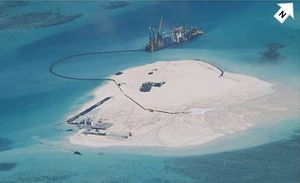Recently released satellite footage gathered by IHS Jane’s has revealed the massive extent of China’s land reclamation projects in the South China Sea. The images show that Beijing has created entirely new islands on a number of reef in the Spratlys, including Fiery Cross Reef, Gaven Reefs, Johnson South Reef, and Hughes Reef.
The Wall Street Journal collected the images and placed them next to satellite footage from early 2014 to make clear the extent of the construction projects. China’s isn’t just building piers and airstrips on existing land (as Taiwan is doing on Itu Aba, for example) – it is creating islands and then building on top of them. In one case, Fiery Cross Reef, the Asia Maritime Transparency Initiative estimates China expanded the size of the existing land more than tenfold, making the new island more than three times larger than Itu Aba (previously the largest of the Spratly Islands).
IHS Jane’s Defence Weekly’s Asia Pacific editor, James Hardy, told the Wall Street Journal that “this is a methodical, well-planned campaign to create a chain of air and sea capable fortresses across the center of the Spratly Islands chain.” The new facilities will presumably provide refueling and supply stations for Chinese naval and aerial patrols of the region – a crucial step if China plans to establish an air defense identification zone (ADIZ) over the South China Sea, as many analysts believe it will.
Other claimants in the South China Sea – including Vietnam, the Philippines, and Taiwan – already have facilities in the South China Sea. However, critics say the scale of China’s projects outweighs anything seen before in the disputed areas. “The sheer acreage of China’s reclamation work over the past two to three years dwarfs anything and everything other claimants have done by many times over,” Daniel Russel, the U.S. assistant secretary of state for East Asian and Pacific affairs, told the WSJ. Another unnamed U.S. official warned that China’s already “unprecedented” efforts are likely to continue: “[I]f anything, it [the land reclamation] looks to be accelerating.”
Beyond the obvious tactical benefits of having “unsinkable aircraft carriers” in the middle of the Spratlys, there are possible legal benefits as well. As Tran Truong Thuy notes in a piece for AMTI, China (unlike the other claimants) insists that the Spratlys should generate not only the standard 12 nautical miles of territorial sea, but a full 200 nmi exclusive economic zone (EEZ). China hopes to bolster this interpretation of UNCLOS by expanding the reefs (some of which were previously underwater at high tide) into “into full-fledged islands that can fulfill the requirement Article 121 of UNCLOS of being able to “sustain human habitation or economic life of their own.”
However, Article 121 also specifies that an island is “a naturally formed area of land” (emphasis added), which would seem to preclude China’s artificial islands from qualifying. Ian Storey of the Institute of Southeast Asian Studies in Singapore told the Wall Street Journal that China wouldn’t be able to use its new islands to solidify its claims in the area.
Still, the wish to legally shore up China’s claims is often posited as a driving force behind the land reclamation projects – particularly as the construction sped up noticeably after the Philippines filed its arbitration case against China’s “nine-dash line” claim in the South China Sea. If there’s a silver lining to China’s land reclamation projects, it may be that China is actively seeking to create facts on the ground that will bring its claims into compliance with UNCLOS – which means re-defining its “nine-dash line” claim to match with the language of EEZs and territorial waters found in UNCLOS. Currently, China’s claims are ill-defined both geographically (where, precisely, does the “nine-dash line” end?) and legally (how much control does China want to assert over the waters within the “nine-dash line”?). Reinterpreting its claim according to UNCLOS (albeit with the original conditions altered to suit China’s interests) would at least provide a solid base for future negotiations — rival claimants would have something to hole onto besides rigid claims to historical sovereignty.
As Greg Austin noted in a recent piece for The Diplomat, China’s refusal to clarify the nine-dash line (which it inherited from the previous Republic of China government) is a major obstacle to untangling the various competing claims — and also a major source of worry among rival claimants. As Austin also notes, China may be edging toward a definitive explanation of the line. A recent article in Eurasia Review by two Chinese researchers from the National Institute for South China Sea Studies says that Beijing is “evaluating” the scope of the rights it wants to exercise in the South China Sea – that’s “why China has not yet clarified the title of rights within the ‘dash-line.’” The implication of the “yet” here is that China will eventually clarify its claims – perhaps after it has finished solidifying control through its extensive land reclamation activities.

































